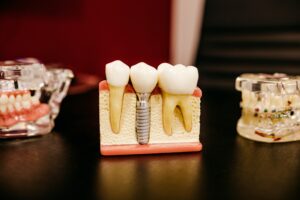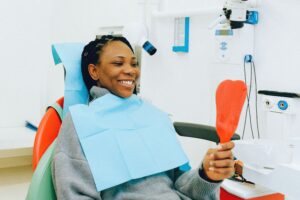
Do you have a dental bridge, and believe your dental bridge needs repair? According to expert dentists of the Lane and Associates, dental bridges can last for decades, but with time, dental bridges need to be repaired or replaced. Usually, a dental bridge is connected to the healthy teeth on either side of the gap in the mouth. The prime purpose of a dental bridge is to restore the bite and keep the face’s natural shape.
If you want to know more about the replacement of the dental bridge, how the bridges are damaged, when to get your dental bridge fixed, how a dental bridge is repaired, and care instructions for dental bridges, you will find that information here. Lane DDS is here to help you avoid dental bridge failure.
Dental Bridge Replacement
Do you want to know about the process of repairing a dental bridge? If yes, then remember that the treatment for a dental bridge repair depends on the reason for the bridge failure. If the problem is with an abutment tooth, Lane DDS will remove the bridge.
Fixed bridges are cemented to the abutment teeth, so this often needs breaking the original bridge. Once the supporting teeth are treated and are healthy, then the replacement bridge can be made.
If your dentist finds out that the abutment teeth can’t be restored, then the teeth can be replaced with implants to support your dental bridge replacement. The abutment teeth along with the missing teeth can also be replaced with implants, which are fixed surgically into the jawbone.
There are a few cases in which the porcelain coating on the bridge is fractured, but the bridge is okay, in such cases the coating can be repaired easily. The expert dentists of Lane and Associates Family Dentistry can sometimes repair a fractured replacement tooth as well depending on the specific case.

How Is A Loose Dental Bridge Fixed?
The dental team at the Lane and Associates Family Dentistry dental bridge repair options depend mostly on why the bridge is loose. In the best-case scenario, the bridge can be removed by breaking the cement on the abutment tooth, the dental problem is addressed, and the same bridge is recemented. If the bridge had a fracture or a chip the bridge can be replaced with a new one.
In some cases, the loose bridge can be due to decay on the abutment tooth, in such conditions the abutment tooth will need to be treated, if possible, by cleaning or root canal. But if the tooth is grossly carious then it will have to be replaced by an implant fixed surgically in the jawbone that can support the new dental bridge.
Is It Common For A Dental Bridge To Fall Out?
There’s a common myth circulating that the dental bridges aren’t fixed and will eventually fall out. Although indeed, the dental bridges do sometimes loosen over time, they can easily be tightened by the dentist at the Lane and Associates Family Dentistry. However, bridges are fabricated to last a lifetime, so the chances of your bridge falling out are minimum.
How Long Does A Dental Bridge Last?
Typically, a dental bridge lasts between 5-15 years in most cases. The durability of a dental bridge depends upon the maintenance of the dental bridge and oral hygiene.
Can A Broken Dental Bridge Be Fixed?
According to the expert Dental team of Lane and Associates Family Dentistry fixing a broken or damaged bridge is determined by the level of the damage and the condition of the surrounding teeth.
In some cases, a simple crack or chip of a bridge can be fixed with a dental bonding material to fill in the gaps and reestablish the strength and shape of the bridge. Sometimes a loose dental bridge can be removed and re-cemented in place if the supporting teeth are still in good condition.
In cases where the supporting teeth are grossly decayed over the years, the bridge or crown may need to be replaced. The Supporting teeth that are indicating signs of decay may no longer fit perfectly with the shape of the old bridge.
How Much Does It Cost To Fix A Broken Bridge?
The average cost for the replacement of a broken dental is between $500 and $1,500. However, an implant-supported bridge costs can start at $5,000. These prices may differ depending on your insurance coverage and what work needs to be done.
Did you know that replacement of the dental bridge is very important, and it’s a good idea to do it whenever it’s required? Lane DDS recommend considering dental bridge replacements to avoid further issues. Prevention and maintenance is the right thing to do if you want great dental health. Don’t hesitate to choose Lane and Associates Family Dentistry to get the best dental treatment in the town!
Is It Difficult to Replace a Dental Bridge?
Replacing a dental bridge can be a bit complicated, but it is a routine procedure for dentists. The difficulty depends on the condition of the abutment teeth (the supporting teeth on either side of the bridge) and the reason for the replacement. If the abutment teeth are healthy, the old bridge can be removed, and a new one can be fitted without much trouble. However, if there is decay or damage to the abutment teeth, they may need treatment or even replacement with dental implants before a new bridge can be placed.
Can Decay Under a Bridge Be Fixed?
Yes, decay under a dental bridge can be fixed, but it often requires removing the bridge. The dentist will carefully take off the bridge to treat the decay on the supporting teeth. Depending on the extent of the decay, this might involve filling cavities or performing a root canal. Once the underlying issue is resolved and the teeth are healthy again, the dentist can either recement the old bridge or fit a new one.
How Can You Tell If a Dental Bridge Is Bad?
There are several signs that a dental bridge may need repair or replacement:
- Pain or Discomfort: If you feel pain or sensitivity around the bridge, it could indicate decay or damage.
- Movement: A bridge that feels loose or shifts in your mouth is a sign that it is not securely attached.
- Visible Damage: Cracks, chips, or other visible damage to the bridge can compromise its effectiveness.
- Gum Issues: Swelling, redness, or bleeding around the bridge may indicate gum disease or decay under the bridge.
- Bad Breath: Persistent bad breath can be a sign of decay or infection around the bridge.
If you notice any of these issues, it’s important to visit your dentist for an evaluation.
How Many Times Can You Replace a Bridge?
There is no set limit to how many times you can replace a dental bridge, but the decision depends on the health of the abutment teeth or implants. If the supporting structures remain healthy, bridges can be replaced as needed. However, each replacement can be more challenging if the abutment teeth become weaker or more damaged over time. In such cases, your dentist might suggest alternative solutions like dental implants.





